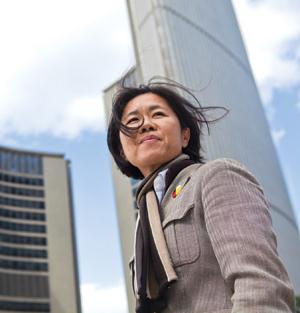
Kristyn Wong-Tam says the BIA initiative is "a move to try to reclaim public space for the public." Credit: Adam Coish

Credit: Adam Coish

Credit: Adam Coish

"If the community boards are insufficient and not visible, then that poses a problem," says Noa Mendelsohn Aviv Credit: Andrea Houston

Credit: Adam Coish
The Church Wellesley Village may soon put on a strip show.
No, not at Flash. But it does involve poles.
A recent push to pretty up the area may result in the neighbourhood’s business group stripping posters from street poles.
Some community members have requested the Church Wellesley Village Business Improvement Area (BIA) put an end to postering on poles to improve street appeal.
At a BIA meeting on Sept 24, co-chair Avery Pitcher told local business representatives that eight-foot-high, rainbow-themed wraps, designed to prevent poster tape from adhering, could soon cover the neighbourhood’s poles.
Their plan is to have 18 wraps on Church Street. Expected to arrive in March, they will cost about $24,000. The BIA says the City of Toronto should pay half as part of a cost-share program. The city will decide whether the BIA will receive funding for the wraps at budget time in March.
Posters in the strip advertise community meetings, dance parties and other local events. According to Pitcher, it’s not the BIA’s intention to eliminate community postering.
“It is our goal to incorporate community postering into the village in a way that enhances the area, rather than seeing one hydro pole after another covered with multiple copies of commercial posters advertising events elsewhere in the City,” Pitcher wrote in a letter that was posted on the BIA website Oct 9.
“There are community postering boards in our area that can and should be used. If more are needed and we are asked, the BIA is willing to ask the City to provide more.”
The BIA declined to comment for this story.
The change could be a problem for many, including event organizers and community activists. They say the promotion of local events on posters brings people and money to the Village.
“Postering allows you to target people where they are,” says Dave Meslin, a public-space activist.
Meslin says that instead of improving business, the BIA may well hurt local revenues by erasing options for community event promotion.
“Postering is really low-cost,” says Dylan Reid, a senior editor at Spacing, an urban landscape magazine. “The people who use postering can’t afford other stuff.”
But Councillor Kristyn Wong-Tam says she has received hundreds of complaints about the posters from Ward 27 constituents. “The residents and business owners have expressed that’s not how they want the face of the community represented,” she says.
So a prettier face is in the works.
“Beautification is all tied in to streetscape improvement and a public realm policy that will make streetscapes appealing to people,” Wong-Tam says.
Robert Levit, an associate professor of architecture at the University of Toronto, believes beautification is often used as a euphemism for commercialization.
“A lot of the time beautification is underwritten by the business improvement districts,” he says. “Usually it means the enforcement of some sort of aesthetic standard which excludes some uses or some forms of expression, like the postering.”
BIA members encourage the use of the BIA website or the neighbourhood’s public message centres to promote events.
Reid believes the internet can help, but not the way posters do, by reaching the entire community. “It still fulfills a role that new forms of social media do not.”
Wong-Tam says the city-provided public message centres are the appropriate place for community notices. She claims the public has told her they want the posters on the community boards. She didn’t take part in the decision to order the community boards or the pole wrappings but says the BIA planned for the public message centres long before the wraps.
According to Meslin, the most interested stakeholders are the companies that do the postering. “Because it’s been professionalized that way, it creates a problem in volume,” he says, noting it comes down to numbers.
Meslin says the BIA must consider how many poles there are and how many community boards are replacing them. “There has to be enough of them,” he says. “You can’t have one community board per block.”
So far there are only four community boards in the Church Wellesley Village, although the BIA plans to install two more.
One board is located outside the 519 Church Street Community Centre on the east side of Church Street, just below Monteith Street. Another is on the northwest corner of Church and Alexander streets, just in front of the Bank of Montreal. The other two are located on the north side of Church and Wellesley streets, on the east and west sides.
Meslin says the boards could be a viable alternative if more are installed in prominent locations.
Wong-Tam believes visual clutter is why some don’t notice the boards. “It’s not surprising when there’s so much on the street competing for attention.”
Meslin thinks otherwise. “If people aren’t aware that they exist, then there probably aren’t enough of them.”
Wong-Tam says the area’s sidewalks have a limited amount of space. By her estimate, they are about two metres wide. Within that small stretch, news boxes, fire hydrants and garbage bins compete for space. The installation of community boards must also take into account mobility factors for the disabled and elderly.
“It’s about finding the right balance,” she says.
More community boards would certainly go a long way toward providing more advertising space. “The less space you have, the more of a mess you have because you have more people fighting for that space,” Meslin explains.
Noa Mendelsohn Aviv, director of the Canadian Civil Liberties Association’s equality program, also sees a potential hitch with the public message centres. “If the community boards are insufficient and not visible, then that poses a problem,” she says.
Postering is legal. In 1993, Ramsden v Peterborough (City) saw the Supreme Court of Canada strike down a bylaw prohibiting all postering on public property on the grounds that the law violated freedom of expression. The case did not quantify space for postering. It set a precedent in other Canadian cities.
“In a situation where there are spaces for community postering, it’s a matter of if it’s adequate,” Aviv says. “If it’s totally inadequate to the needs of the community, it is a violation of freedom of expression.”
Toronto has tried to regulate postering in the past. For instance, the city attempted to pass an anti-postering bylaw in 2002 and again in 2005. Meslin led the Toronto Public Space Committee’s campaign against the potential ban and won. “It’s a fight that has to be won over and over,” he says.
In 2010, after the city passed several amendments, the temporary sign bylaw came into effect. The bylaw regulates permit requirements and fees and the size and location of temporary signs on public and private property. It also requires that sign providers hold business licences under Chapter 545 of the Toronto Municipal Code. Schools, community, charitable and religious organizations are not required to get permits to put up temporary signs.
Meslin thinks there’s room for regulation and enforcement. “You often have conflicting needs,” he says. “Good policy tries to address these needs.”
Wong-Tam believes the BIA is responding to members by making the move to regulate postering. She concedes it won’t be easy. “They’re not going to be able to police it,” she says. “They don’t have the resources.”
She says the situation concerning postering is not exclusive to the Church Wellesley Village; other BIAs in the city are asking for the same.
“It’s really a move to try to reclaim public space for the public,” she says.
Other neighbourhoods have also tried to reduce postering on poles. Councillor Adam Vaughan says he supports the use of pole wraps in Koreatown, the Annex and the Entertainment District.
“It’s a response to people that over-poster,” he says. “I don’t have any objection to it.”
He backs the wraps because he believes they speak to community rather than private interests. “The clutter and commercialization of public space is not a good value,” he says.
His thoughts on the correct approach to postering lean toward regulation. “It should be a framed practice, not an absolute right.”
While enforcement may be lax, postering in the Village is a restricted right.
Still, Wong-Tam claims that event promoters usually don’t ask Toronto Hydro, which owns the utility poles, for permission to advertise on the posts. By contrast, she says, the BIA approached the corporation about wrapping the poles in the rainbow design.
The councillor also points out that advertisers plaster entire poles with the same ads, and often, they don’t take down what they put up.
A recent walk through the neighbourhood revealed that most poles were not swarmed. The community boards, on the other hand, were much harder on the eyes.
As with the poles, advertisers tend to poster both sides of the boards. This makes it particularly difficult for other event promoters to find space for their ads. Some have taken to postering over other ads.
Astral Media is responsible for the maintenance of the public message centres. The boards are part of the street furniture program, a 20-year agreement the City of Toronto made with Astral Media Outdoor LP in 2007. The company places the boards in consultation with BIAs or with local councillors if an area doesn’t have a BIA.
Supporters of postering see it as a sign of community engagement, not space filler. They suggest that if the BIA’s ultimate goal is to clean up the Village, perhaps it can consider other methods of doing so.
“If they’re concerned about garbage, put out more garbage cans. If they’re concerned about street appeal, put up more public art,” Reid says.
Wong-Tam says the BIA can’t provide sufficient funds for a designated street-cleaning crew.
Postering, while deemed dirty by some, is seen by others as the sign of an active, lively neighbourhood. “There’s a vibrancy to be found there,” Reid says.
Meslin agrees. “There’s nothing beautiful about whitewashing a community,” he says. “Expression is beautiful.”
Wong-Tam thinks such insinuations are baseless. “No one is trying to sanitize anything,” she argues.
To drive that point home, city officials and the business community might consider giving the entire neighbourhood a say on the matter.
“They’re not working with the community at all,” says Dennis O’Connor, founding chair of the Church Wellesley Village BIA. According to O’Connor, postering was also a matter of contention during his time with the BIA.
“It’ll always be an issue because there are many people within the community that want to clean it up,” he says.
A survey of posters in the neighbourhood reveals that most promote dance parties and fetish events.
Does the content of the ads have anything to do with the push to regulate postering? Many feature sexual images that some residents and business representatives could do without.
“Sweaty, hot guys in jockstraps no longer cut it for them,” O’Connor, who now lives in Ottawa, says. “They don’t want it there.”
But he insists the posters are helpful. For out-of-towners who have no clue where the community boards are, access to information could become a problem.
“For me, especially now that I show up in Toronto maybe once or twice a year, the posts are where I go first,” he says.
Why beautification so often means going after community expression has many stumped. Postering as a method of expression has long been a constant in Toronto’s queer community, from the early days of AIDS activism to Will Munro.
At the dawn of the gay rights movement in Toronto, activists used street poles to keep the community informed.
“A lot of people fought and used those posts to rally our community,” O’Connor says. He recalls community members putting up posters during the bathhouse raids and the AIDS epidemic.
“Those posts should actually be put down as national historical markers,” he says.
At the least, the continued use of the poles to engage the community could serve as a contemporary monument to the pioneers who once used street poles to launch the movement that eventually turned the neighbourhood into what it is today.


 Why you can trust Xtra
Why you can trust Xtra


